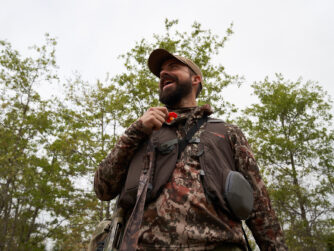The wild turkey stands as one of the most iconic game birds in North America, captivating hunters, biologists, and nature enthusiasts alike. With its fascinating behavior, keen senses, and complex social dynamics, the wild turkey is a marvel of the natural world. IRenowned turkey biologist Dr. Mike Chamberlain shares his deep insights into the biology, behavior, and hunting nuances of the bird we love.
This is a companion post to S1 E3
Understanding the Wild Turkey
Turkeys are incredibly intelligent and cautious birds with an extraordinary ability to adapt to their environment. Dr. Chamberlain describes them as creatures with a “sense of place,” meaning they have an acute awareness of their surroundings and react to threats with precision. Unlike many animals, each turkey is unique in personality, behavior, and response to hunting pressure.
One of the most striking features of wild turkeys is their exceptional eyesight and hearing. Their vision spans almost 360 degrees, allowing them to detect the slightest movements. Their hearing works independently in each ear, enabling them to pinpoint sounds with incredible accuracy. This combination of keen senses makes them one of the most challenging game species to hunt.
The Life Cycle of a Wild Turkey
Turkeys go through distinct life stages, each marked by unique behaviors and challenges. After hatching, poults rely on their mothers for protection and guidance. Within two weeks, they begin roosting off the ground to avoid predators. As they mature, young males (jakes) and females (hens) separate into gender-specific flocks.
By winter, large flocks form, but as spring approaches, these flocks dissolve, and turkeys move to breeding areas. Males establish dominance through strutting, gobbling, and sometimes aggressive encounters. Dominant toms typically have priority access to hens, though multiple toms may father a single clutch of eggs. Hens, on the other hand, become solitary during nesting, carefully selecting locations that provide cover and security.
The Science of Gobbling and Communication
Gobbling is one of the most recognized turkey vocalizations, serving as a primary means of communication during the breeding season. Dr. Chamberlain explains that gobbling is influenced by various factors, including daylight length, testosterone levels, and social dynamics. Interestingly, turkeys also react to external stimuli such as crow calls, coyote howls, and even loud noises like gunshots, a phenomenon known as the “shock gobble.”
Beyond gobbling, turkeys produce over 20 different vocalizations, ranging from soft purrs and clucks to aggressive fighting purrs. These calls serve different purposes, including maintaining contact with flock members, signaling alarm, and attracting mates. Researchers have also discovered that turkeys can recognize individual voices within their flocks, adding another layer of complexity to their communication.
Survival Instincts and Predator Response
Turkeys exhibit remarkable survival strategies in response to threats. Unlike other game animals that flee at the first sign of danger, turkeys assess each situation carefully. In some cases, they may remain motionless to avoid detection; in others, they take flight as a last resort. Dr. Chamberlain’s research using GPS tracking has shown that turkeys react differently to natural predators versus human hunters. While they may return to normal behavior quickly after encountering a coyote, they often change their movement patterns or even vacate an area after a close call with a hunter.
Interestingly, dominant toms can be so consumed by asserting their status that they sometimes ignore danger. Many hunters have witnessed gobblers attacking a downed rival, even in the presence of humans, because their instinct to dominate outweighs their survival instincts in that moment.
The Challenges of Hunting Wild Turkeys
Hunting wild turkeys is as much an art as it is a science. Understanding their habits, vocalizations, and reactions to different situations can greatly increase a hunter’s chances of success. Dr. Chamberlain advises hunters to be patient and to study turkey behavior carefully. Some birds respond aggressively to calls, while others remain silent and approach cautiously.
A common debate among hunters is whether to call to turkeys while they are still on the roost. Dr. Chamberlain suggests that it depends on the situation. If a hunter is in a prime location, it may be best to stay silent until the turkey flies down. However, in uncertain scenarios, a few soft yelps can sometimes entice a gobbler to investigate.
Another crucial aspect of turkey hunting is recognizing how turkeys establish daily movement patterns. While some turkeys follow a predictable loop throughout the day, others change their routes based on factors like food availability, predator presence, and past experiences. Experienced hunters learn to anticipate these movements and position themselves accordingly.
The Mystery Remains
Despite decades of research, much about wild turkeys remains a mystery. Dr. Chamberlain emphasizes that turkeys are individuals with unique behaviors, making them an endlessly fascinating species to study and hunt. Their intelligence, wariness, and social complexity continue to challenge and intrigue those who pursue them.
As hunters and conservationists, it is essential to appreciate and respect the wild turkey, ensuring that future generations can experience the thrill of the hunt and the wonder of observing these incredible birds in their natural habitat. Whether you are a seasoned turkey hunter or someone just beginning to learn about these birds, one thing remains certain: the wild turkey will always keep us guessing.






